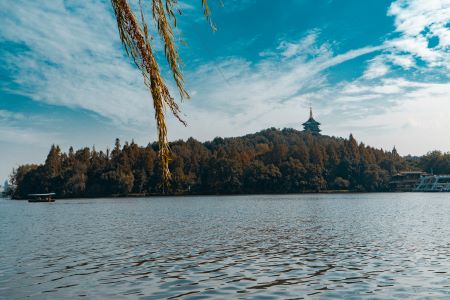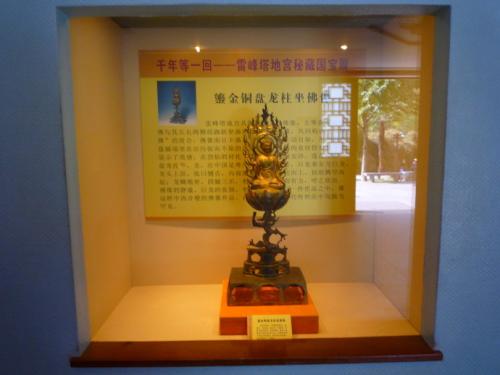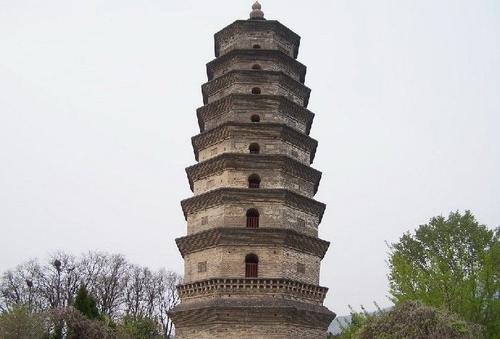Chinese Name: 雷峰塔 Pronunciation: Léifēng Tǎ
Covering Area: 0.08 km²
Suggested Visiting Hours: 1-2 Hours
Construction Time: 977 AD in the Northern Song Dynasty (960 AD-1127 AD)
Address: No.15 Nanshan Road, West Lake District, Hangzhou City, Zhejiang Province, China
| Tourists | Price |
| Adults | 40 yuan |
| Minors (6-18 years old) | 20 yuan |
| Seniors (over 70 years old) | 20 yuan |
1. Children under 6 years old or shorter than 1.2 meters are free of charge;
2. The disabled with valid certificates are free of charge.
| Date | Opening Hours | |
| Gate | Ticket Offfice | |
| November 1st –March 15th | 8:00-17:30 | 8:00-17:00 |
| March 16th – April 30th | 8:00-19:00 | 8:00-18:30 |
| May 1st – October 31st | 8:00-20:00 | 8:00-19:30 |

Leifeng Pagoda, also known as the Imperial Concubine Pagoda or Xiguan Brick Pagoda, is located on the Lei Peak of the Xizhao Mountain on the south bank of the West Lake Scenic Area in Hangzhou, capital of Zhejiang Province. Leifeng Pagoda was first built in 977 AD by Qian Chu, King of Wuyue Kingdom, for worshiping Buddhist relics. According to the legend, it was built to celebrate the Imperial Concubine Huang giving birth to a baby, so it was named “Imperial Concubine Pagoda”. Later, it was gradually called “Leifeng Pagoda” because the peak on which it stood was called “Lei Feng”.
The old Leifeng Pagoda collapsed in 1924 and was rebuilt. The newly built Leifeng Pagoda is the first colored copper pagoda in China. Leifeng Xizhao (Leifeng Pagoda at sunset) is one of the Ten Views of the West Lake, and one of the famous tourist attractions of West Lake in Hangzhou.
The total height of the new tower is 71 meters, of which the base is 9.8 meters high, the tower body is 45.8 meters high, and the spire is 16.1 meters high. The new tower base covers an area of 3,133 square meters, and the construction area of the tower body covers 2,956 square meters, and the total construction area is 6,089 square meters. On the volume, the base diameter of the new tower is 60 meters, the side length is 23.34 meters, and the circumference is 186.72 meters. The diameter of the tower body is 28 meters, the side length is 11 meters, and the circumference is 88 meters.

In 977 of the Northern Song Dynasty (960-1127), it was built on Xizhao Mountain on the south bank of the West Lake.
In 1120, the second year of Xuanhe reign of the Northern Song Dynasty, Leifeng Pagoda was seriously damaged by wars. During the Qingyuan reign of the Southern Song Dynasty (1195-1200), it was rebuilt and the buildings were restored to their golden splendor.
After the Southern Song Dynasty, “Leifeng Xizhao” has become one of the most popular scenic spots in the West Lake.
During the reign of Emperor Jiajing (1522-1566) of the Ming Dynasty (1368-1644), Hangzhou was besieged by the Japanese pirates who invaded the southeastern coastal areas and they set fire to the Leifeng Pagoda. After the disaster, only the brick body of the ancient pagoda left.
In the early Qing Dynasty (1636-1912), Leifeng Pagoda, with the myth and legend of the White Snake, became a popular scenic spot among the Ten Views of the West Lake after the two emperors, Kangxi and Qianlong, visited the Pagoda many times, and “Leifeng Xizhao” was widely known.

From the late Qing Dynasty to the early Republic of China (1912-1949), it was widely said that the bricks of Leifeng Pagoda had the special functions of “exorcising evil spirits” and “benefiting silkworms breeding”, so the bricks were repeatedly stolen. On September 25, 1924, the Leifeng Pagoda finally collapsed after years of disrepair. The collapse of Leifeng Pagoda aroused the attention and discussion of the whole society. People had been looking forward to the reconstruction of this famous ancient pagoda.
In July 1999, Zhejiang Provincial Party Committee and Zhejiang Provincial Government made the decision to rebuild Leifeng Pagoda and restored the landscape of “Leifeng Xizhao”, and set up the provincial “Double Scenic” coordination group and an office.
On December 26, 2000, the foundation stone laying ceremony was launched for the reconstruction of Leifeng Pagoda.
On March 11, 2001, the underground palace of Leifeng Pagoda began to be excavated. The underground palace of Leifeng Pagoda is small in volume, about 0.5 meters long and 0.5 meters wide, with a depth of about 1 meter according to the detection. The excavation of the Leifeng Pagoda site and the underground palace unearthed a number of exquisite cultural relics and treasures, including the sterling Ashoka Pagoda of Wuyue Kingdom and the gilded Buddha statue, which caused a sensation at home and abroad.
On October 25, 2002, the reconstruction of Leifeng Pagoda was completed. Zhang Dejiang, the former secretary of Zhejiang Provincial Party Committee, and Xi Jinping, the former deputy secretary of Zhejiang Provincial Party Committee and acting governor, jointly unveiled the plaque for the new tower.
Leifeng Xizhao Scenic Spot, covering an area of 8 hectares after the reconstruction, includes Leifeng Pagoda, Xizhao Pavilion, Miaoyin Platform, Huiwen Pavilion, Fangda Guangming Pavilion, Ruyiyuan Tourist Center, and Ouxiangju Restaurant, managed and operated by Hangzhou Leifeng Culture and Tourism Development Co., Ltd.
Since its reopening, the scenic spot has received many leaders of the party and the state, such as Jiang Zemin, Wu Bangguo, Li Peng, Li Ruihuan, Yu Jianxing, and Li Lanqing.

The legend of the White Snake has a long history. In the Qing Dynasty, new edition of the story of the White Snake appeared and it has spread up to now. Legend goes that in Zhenjiang City during the Song Dynasty, Bai Suzhen was a snake demon who had trained herself to be an immortal for thousands of years. In order to repay the scholar Xu Xian for saving her life in a previous life, she transformed into a human form and wanted to repay his kindness. Bai Suzhen used her magic to meet Xu Xian and married him. After the wedding, Fa Hai, a monk of Jinshan Temple, told Xu Xian that Bai Suzhen was a snake demon. Xu Xian was not convinced but uncertain. Later Xu Xian followed Fa Hai’s method and let Bai Suzhen drink the wine with realgar on the day of Dragon Boat Festival. Bai Suzhen appeared in her true form as a white snake and scared Xu Xian to death. Bai Suzhen went to heaven to steal the immortal herb, lucid ganoderma, to save Xu Xian’s life. Fa Hai then cheated Xu Xian to Jinshan Temple and controlled him, Bai Suzhen and Xiaoqing (Bai’s sister, a green snake), fought with Fa Hai, and make the water flood Jinshan Temple, but other creatures were also hurt by their action. Because of the violation of the heavenly laws, Bai Suzhen was repressed in Leifeng Pagoda after giving birth to a child. Later Bai Suzhen’s son grew up to be the Number One Scholar. He went to the pagoda and rescued his mother. The whole family reunited.

The entrance to the thousand-year underground palace of Leifeng Pagoda is located at the heart of the pagoda. The entrance is surrounded by the remains of the pagoda. On March 11, 2001, the underground palace of Leifeng Pagoda began to be excavated. The underground palace of Leifeng Pagoda is small in size, about 0.5 meters long and 0.5 meters wide, and about 1 meter deep according to the detection.
After excavation, it was found that a large number of offerings were placed in the underground palace, including 60 pieces of precious cultural relics, such as a bronze Buddha statue on a lotus pedestal and an iron box that contained the hair of Buddha, as well as thousands of ancient coins. Among them, the iron box is 50 centimeters high and weighs more than 100 kilograms. The gilded pagoda in the mysterious iron box is an exquisite gilded tetragon pagoda, made of silver and gilded gold outside. The pagoda is 35 centimeters high, and the base is square, and the side is 12.6 centimeters long. The pagoda is covered with rust, and the four sides of the pagoda are decorated with reliefs of Buddha’s stories. At the bottom of the tower is a gilded silver box, and the lid of the box is decorated with double phoenix and peony pattern. Around the silver box was a leather belt inlaid with twelve fine silver ornaments.

The excavation of the Leifeng Pagoda site and the underground palace has made people have a more intuitive understanding of the shape and construction of the typical octagonal tower during the Five Dynasties period. It is a famous tower with the first octagonal plane and a pavilion style in the history of Chinese tower buildings. The scale is magnificent and the structure is outstanding, also soft and gorgeous, with extremely high artistic, historical and cultural value.
The statue is 68 centimeters high and has two bases. There is a dragon on the lower base and the dragon has a lotus throne. The Buddha is situated on the lotus throne. It is a national first-class cultural relic.

The sterling silver Ashoka Pagoda is a container to place the relics of Buddha’s hair. As a national treasure, this silver pagoda has been collected in Zhejiang Provincial Museum. The Ashoka Pagoda, containing the Buddhist relics in a gold coffin, is the core of the Imperial Concubine Pagoda (Leifeng Pagoda) built by the King of Wuyue Kingdom, as well as the embodiment of his lifelong worship for Buddhism. The gold coffin in the silver tower with its unique significance is the highest standard to bury Buddhist relics.
Leifeng Pagoda - Xizhao Pavilion - Miaoyin Platform - Huiwen Pavilion – Fangda Guangming Pavilion - Ouxiangju Restaurant
The four seasons are all appropriate, so you can go there according to your time. It has various sceneries in different times. If you want to visit the West Lake at the same time, it would be better to come here in spring or in autumn, because in spring, the weather is warm and you can enjoy the blooming flowers and growing grass and willows and other hopeful scenery; in autumn, the osmanthus flowers are in bloom and it would be wonderful to wander along the West Lake and you will be embraced by the aroma. There is more rain in other seasons.
Take bus 4B, 4, 31, 315, 1314, 507H, and get off at Jingsi Station.
Chinese: 请带我去雷峰塔。English: Please take me to the Leifeng Pagoda.
If you go to Leifeng Pagoda by taxi, it takes about 45 minutes and about 50 yuan from Hangzhou East Railway Station.
If you go to Leifeng Pagoda by taxi, it takes about 20 minutes and about 15 yuan from Hangzhou Railway Station.
If you go to Leifeng Pagoda by taxi, it takes about 50 minutes and about 120 yuan from Hangzhou Xiaoshan International Airport.
